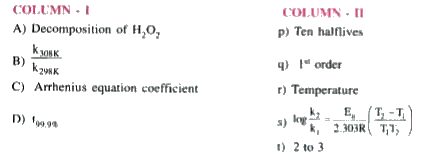For reaction A→B the rate constant k1=A1e−Ea1/RT and for the reaction P→Q the rate constant k2=A2e−Ea2/RT. If A1=108,A2=1010 and Ea1=600,Ea2=1200, then the temperature at which k1=k2 is Solution in Telugu
600RK
300×4.606RK
6004.606RK
4.606600RK
The correct Answer is:C
K1=K2,A1.e−Ea1/RT1=A2.e−Ea2/RT2,A1A2=⎛⎜
⎜⎝e−ε2RTe−εa1/RT⎞⎟
⎟⎠:A1A2=e(εna1−εa2RT)
2.303log1081010=600−1200RT,2.303×(−2)=−600RT,T=6002.303×2×R=(6004.606R)) Kelvin
Topper's Solved these Questions
- CHEMICAL KINETICSBOOK - AAKASH SERIESCHAPTER - CHEMICAL KINETICSEXERCISE - PRACTICE SHEET-3 (LINKED COMPREHENSION TYPE QUESTIONS)
6 Videos
- CHEMICAL KINETICSBOOK - AAKASH SERIESCHAPTER - CHEMICAL KINETICSEXERCISE - PRACTICE SHEET-3 (MATCH THE FOLLOWING QUESTIONS)
2 Videos
- CHEMICAL KINETICSBOOK - AAKASH SERIESCHAPTER - CHEMICAL KINETICSEXERCISE - PRACTICE SHEET-2 (INTEGER ANSWER TYPE QUESTIONS)
6 Videos
- CHEMICAL KINETCSBOOK - AAKASH SERIESCHAPTER - CHEMICAL KINETCSEXERCISE - EXERCISE - 3.2
45 Videos
- CHEMICAL THERMODYNAMICSBOOK - AAKASH SERIESCHAPTER - CHEMICAL THERMODYNAMICSEXERCISE - Additional Practice Exercise
54 Videos
Similar Questions
For a chemical reaction A→ products, the following equation is found to be followed, logK=16.398−2800T
Arrhenius factor for the reaction is ______
View SolutionMatch the following columns

View SolutionFor a reaction the graph drawn between half life period and reciprocal of initial concentration(1/a) gives a straight line with positive slope. The magnitude of the slope is 500 and iniital concentration of the reactant is 2M. If the initial rate of the reaction is represented as x×10−3 units, then the value of x is _____________
View SolutionDiscuss on the kinetic spontaneity of a chemical reaction. Is a slow reaction spontaneous? Why?
View SolutionWhich among the following is not an exact differential?
View SolutionA certain endothermic reaction: Ararr Product, DeltaH=+ve proceeds in a sequence of three elementary steps with the rate constants K_(1), K_(2) and K_(3) and each one having energy of activation E_(a), E_(2) and E_(3) respectively at 25^(@)C . The observed rate constant for the reaction is equal to K_(3) sqrt(K_(1)/K_(2)). A_(1), A_(2) and A_(3) are Arrhenius parameters respectively. The observed energy of activation for the reaction is:
View SolutionThe Arrhenious equation for the decomposition of methyl nitrite and ethyl nitride are k_(1) and k_(2) respectively and the activation energy of second is 4 kJ//"mole" is more than that of first. At what temperature value of rate constant k_(1) will be equal to k_(2) if k_(1) (s) = 10^(13) (e^(-(E_(a_(1)))/(RT))) and k_(2)(s^(-1)) = 10^(14) (e^(-(E_(a_(2)))/(RT)))
View SolutionFor reaction A rarr B , the rate constant K_(1)=A_(1)(e^(-E_(a_(1))//RT)) and the reaction X rarr Y , the rate constant K_(2)=A_(2)(e^(-E_(a_(2))//RT)) . If A_(1)=10^(9) , A_(2)=10^(10) and E_(a_(1)) =1200 cal/mol and E_(a_(2)) =1800 cal/mol , then the temperature at which K_(1)=K_(2) is : (Given , R=2 cal/K-mol)
View SolutionFor reaction A→B, the rate constant k1=A−Ea1/(RT)1 and for the reactio X→Y, the rate constant k2=A−Ea1/(RT)2 . If A1=108,A2=1010 and Ea1=600 cal /mol, Ea2=1800 cal/mol then the temperature at which k1=k2 is (Given :R=2 cal/K-mol)
View SolutionA reaction takes place in three steps with individual rate constant and activation energy,
Rate constantActivation energyStep 1k1Ea1=180kJ/molStep2k2Ea2=180kJ/molStep3k3Ea3=180kJ/mol
oveall rate constant, k=(k1k2k3)2/3 overall activation energy of the reaction will be :
View SolutionFor reaction A→B, the rate constant k1=A1e−Ea/RT and for the reaction P→Q, the rate constant k2=A2e−Ea2/RT. If A1=108,andEa1=600cal/mol,Ea2=1200cal/mol, then the temperature at which k1=k2 is (R=2cal/K-mol)
View SolutionRate of two reaction whose rate constants are k_(1)& k_(2) are equal at 300 k such that: So caculate n(A_(2))/(A_(1))=?" "Ea_(2)=Ea_(1)=2RT.
View SolutionA reactant (A) froms two products, Aoverset(k_(1))toB , Activation Energy E_(a_(1)) Aoverset(k_(2))toB , Activation Energy E_(a_(2)) If E_(a_(1))=2E_(a_(2)) , then k_(1) and k_(2) are related as:
View SolutionA reactant (A) forms two products : A overset(k_(1))to B , Activation Energy E_(a_(1)) A overset(k_(2))to C , Activation Energy E_(a_(2)) If E_(a_(2))=2E_(a_(1)) , then k_(1) and k_(2) are related as
View SolutionA reactant (A) forms two products :
Ak1−−→B activation energy Ea1
Ak2−−→C activation energy Ea2
If Ea2=2Ea1, then k1 and k2 will be related as
View Solution
